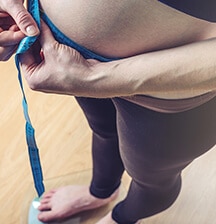
One in every three women who have had a baby, experience some form of urinary incontinence, so if you’re currently pregnant, you should definitely do your Kegels! Here is some advice on how to strengthen an already weakened pelvic floor and ways to avoid those accidental leaks.
Pelvic floor muscles are not the most talked about region of the body, but they are one of the most important. A strong pelvic floor provides support to the bladder, uterus and bowel. If pelvic floor muscles become weak, problems such as incontinence (loss of bladder and bowel control), prolapse and loss of sexual feeling can occur.
Alarmingly, an estimated 1.1 million New Zealanders suffer from some form of incontinence, and while having problems with incontinence is common, it shouldn’t be regarded as normal. Many think that “a pad will solve this”, yet it is not something that women should have to put up with. The New Zealand Continence Association is working to change this perception, and offer practical advice to women with incontinence and pelvic floor problems.
Women often experience incontinence during pregnancy and following childbirth, and a lack of hospital-based post-natal classes means that often mothers are suffering. Women’s health physiotherapist and mother of three, Lisa Yates, runs her own practice and commonly treats new mothers who haven’t been given adequate information. “I repeatedly see women with pelvic floor issues, reporting that they were never made aware of how pregnancy and birth places them at risk,” she says.
Pregnancy and childbirth place increased strain on the pelvic floor, causing the muscles to stretch and weaken. If these muscles aren’t correctly strengthened following pregnancy, problems are likely to persist. Research has shown that incontinence following childbirth can be exacerbated through incorrect exercise. During exercise, pressure is created in the abdominal cavity. If this is too great, the pelvic floor can be forced downwards causing it to further stretch and weaken.
Women with weak pelvic floors shouldn’t be discouraged from exercising, but they should ensure they have a pelvic floor-safe exercise programme, put together by a professional. Many women, wanting to regain their figure, return to exercise with a vengeance, unaware of the damage that can be caused to their already weakened pelvic floor.
Incontinence and prolapses can occur if women return to exercise too soon or choose exercises that are not pelvic floor-safe. Cardio exercises to avoid include (among others): running, jumping, star jumps, skipping, and boxing. Resistance exercises to avoid include (among others): abdominal exercises (sit-ups, curl ups, crunches, etc), deep, wide-legged or jump squats, deep or side lunges, full pushups, deadlifts, and lifting or pressing heavy weights.
However, incontinence and pelvic floor dysfunction are often preventable and can be treated through exercises that strengthen the pelvic floor. Sometimes referred to as ‘kegels’, pelvic floor exercises can be done any time and are easy once you’ve learnt the correct technique.
strengthening your pelvic floor
- Starting seated or lying down is easiest, with relaxed leg, back and bottom muscles. Tighten and lift your pelvic floor as if you are trying to stop a wee. As the muscles strengthen, you can progress to exercise while standing. Like any activity, start with what you can achieve comfortably, and progress from there.
- Lift your muscles quickly and strongly, and hold for 10 seconds before relaxing the muscles completely. Rest in between each lift for 3-5 seconds. Repeat these exercises eight to 12 times (this is one set). Aim for three sets per day.
- As with any muscle you are aiming to strengthen, you may only be able to achieve a few lifts at one time. If your muscles are weak, allow more rest time in between each lift. As you continue and your pelvic floor muscles become stronger, you will be able to do more repetitions.
- To improve the strength and function of your pelvic floor muscles, aim to exercise them every day for at least three months. Significant improvement in pelvic floor muscle strength may take three to six months of regular training. After this point, it is recommended that you continue exercising, to maintain strength and function. Aim to do three sets, three times a week. Keeping within a healthy weight range will help to maintain pelvic floor strength.
- Do other exercises to stimulate good pelvic floor function, such as walking, swimming or pilates.
further help
If you are unsure on the Kegel technique, or feel you have symptoms such as leaking or heaviness in the pelvic region, you should seek professional advice. A pelvic floor physiotherapist or continence nurse can assess your symptoms, teach you how to do the exercises correctly and help you to effectively strengthen this region. A women’s health physiotherapist or continence advisor can design an individual training programme for you, to ensure you are exercising safely.
useful websites
The New Zealand Continence Association can provide more information, advice and a list of trained continence professionals in your area. Call the helpline on 0800 650 659 or visit their website: continence.org.nz
Additional information can be found at physiotherapy.org.nz
By Marieke Esveld








